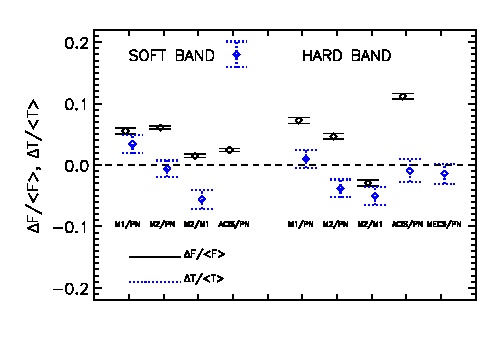In this page you find the spectra, responses and background files necessary to reproduce the spectral analysis in Nevalainen et al., 2010 (A&A, 523, 22) which yielded results summarised in Fig 1.
Fig.1: The average relative difference (diamonds) +- the error of the mean of the fluxes (solid line) and temperatures (dotted line) for different instrument pairs in the soft band (left side of the plot) and in the hard band (right side of the plot)

SASv9.0 was used for processing the XMM-Newton data with calibration information from December 2009 (see details).
XMM-Newton MOS1 and MOS2 spectra and responses are combined and referred to as MOS instrument.
Chandra data are processed with CIAO 4.2. (see [details|^Chandra_data_analysis.txt]).
For most clusters the Chandra data are obtained with ACIS-S, but for some ACIS-I is used, and marked accordingly.
The script files bestfit....xcm will set up the best fit. In more detail:
- The scripts use a 1-temperature phabs x mekal model.
- The column density is from Kalberla et al. (2005) and the absorption cross-sections are from Balucinska-Church & McCammon (1992).
- The scripts use the metal abundance table from Grevesse & Sauval (1998).
- 2. and 3. term in the script file name are the inner and outer radii of the spectrum extraction annulus in arcmin.
- *hard*, *soft* and *wide* refer to the fits done in 2.0-7.0 keV, 0.5-2.0 keV and 0.5-7.0 keV bands, respectively.
- *fe* refers to the Fe XXV/XXVI "constr." fit in [6.45 - 7.25]/(1+z) band, i.e. with a prior for the emission measure.
For flux comparison, scale the measured fluxes to the full annulus by dividing with the fraction of the covered full annulus
The following links provide a single tar file for each cluster-instrument combination, containing the spectral analysis material described above:
Cluster Instrument
A1795 [XMM-Newton/pn|^a1795_pn.tar.gz] [XMM-Newton/MOS|^a1795_mos.tar.gz] [Chandra/ACIS-S|^a1795_aciss.tar.gz]
A2029 [XMM-Newton/pn|^a2029_pn.tar.gz] [XMM-Newton/MOS|^a2029_mos.tar.gz] [Chandra/ACIS-S|^a2029_aciss.tar.gz]
A2052 [XMM-Newton/pn|^a2052_pn.tar.gz] [XMM-Newton/MOS|^a2052_mos.tar.gz] [Chandra/ACIS-S|^a2052_aciss.tar.gz]
A2199 [XMM-Newton/pn|^a2199_pn.tar.gz] [XMM-Newton/MOS|^a2199_mos.tar.gz] [Chandra/ACIS-S|^a2199_aciss.tar.gz]
A262 [XMM-Newton/pn|^a262_pn.tar.gz] [XMM-Newton/MOS|^a262_mos.tar.gz] [Chandra/ACIS-S|^a262_aciss.tar.gz]
A3112 [XMM-Newton/pn|^a3112_pn.tar.gz] [XMM-Newton/MOS|^a3112_mos.tar.gz] [Chandra/ACIS-S|^a3112_aciss.tar.gz]
A3571 [XMM-Newton/pn|^a3571_pn.tar.gz] [XMM-Newton/MOS|^a3571_mos.tar.gz] [Chandra/ACIS-S|^a3571_aciss.tar.gz]
A85 [XMM-Newton/pn|^a85_pn.tar.gz] [XMM-Newton/MOS|^a85_mos.tar.gz] [Chandra/ACIS-I|^a85_acisi.tar.gz]
Coma [XMM-Newton/pn|^coma_pn.tar.gz] [XMM-Newton/MOS|^coma_mos.tar.gz] [Chandra/ACIS-I|^coma_acisi.tar.gz]
HydraA [XMM-Newton/pn|^hydraa_pn.tar.gz] [XMM-Newton/MOS|^hydraa_mos.tar.gz] [Chandra/ACIS-S|^hydraa_aciss.tar.gz]
MKW3S [XMM-Newton/pn|^mkw3s_pn.tar.gz] [XMM-Newton/MOS|^mkw3s_mos.tar.gz] [Chandra/ACIS-I|^mkw3s_acisi.tar.gz]
The following links contain some tabulated data from Nevalainen et al., 2010 paper in electronic form.
The first column gives the number X the of the cluster name AX, except for non-Abell names:
Coma = 1111, HydraA = 2222, MKW3S = 3333
Note that for A262 the soft and wide band temperatures are not presented, but instead marked with -999
[XMM-Newton pn temperatures obtained within Chandra-driven regions|^t_pn_acisreg.data]
[Chandra ACIS temperatures|^t_acis_caldb4.2.data]
[XMM-Newton pn, MOS1 and MOS2 wide band temperatures with large XMM-only regions|^t_pn_m1_m2_widereg_wideband.data]